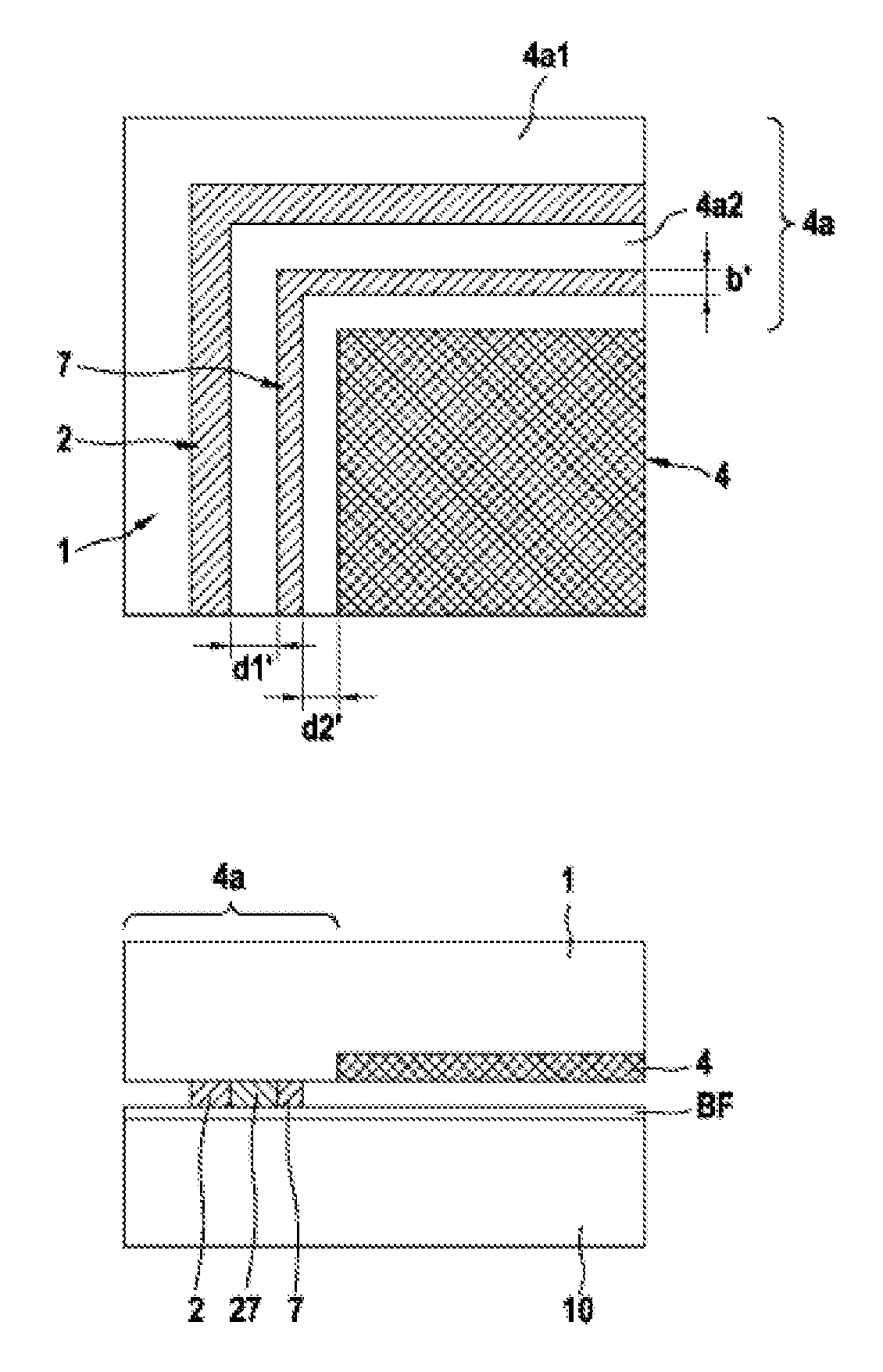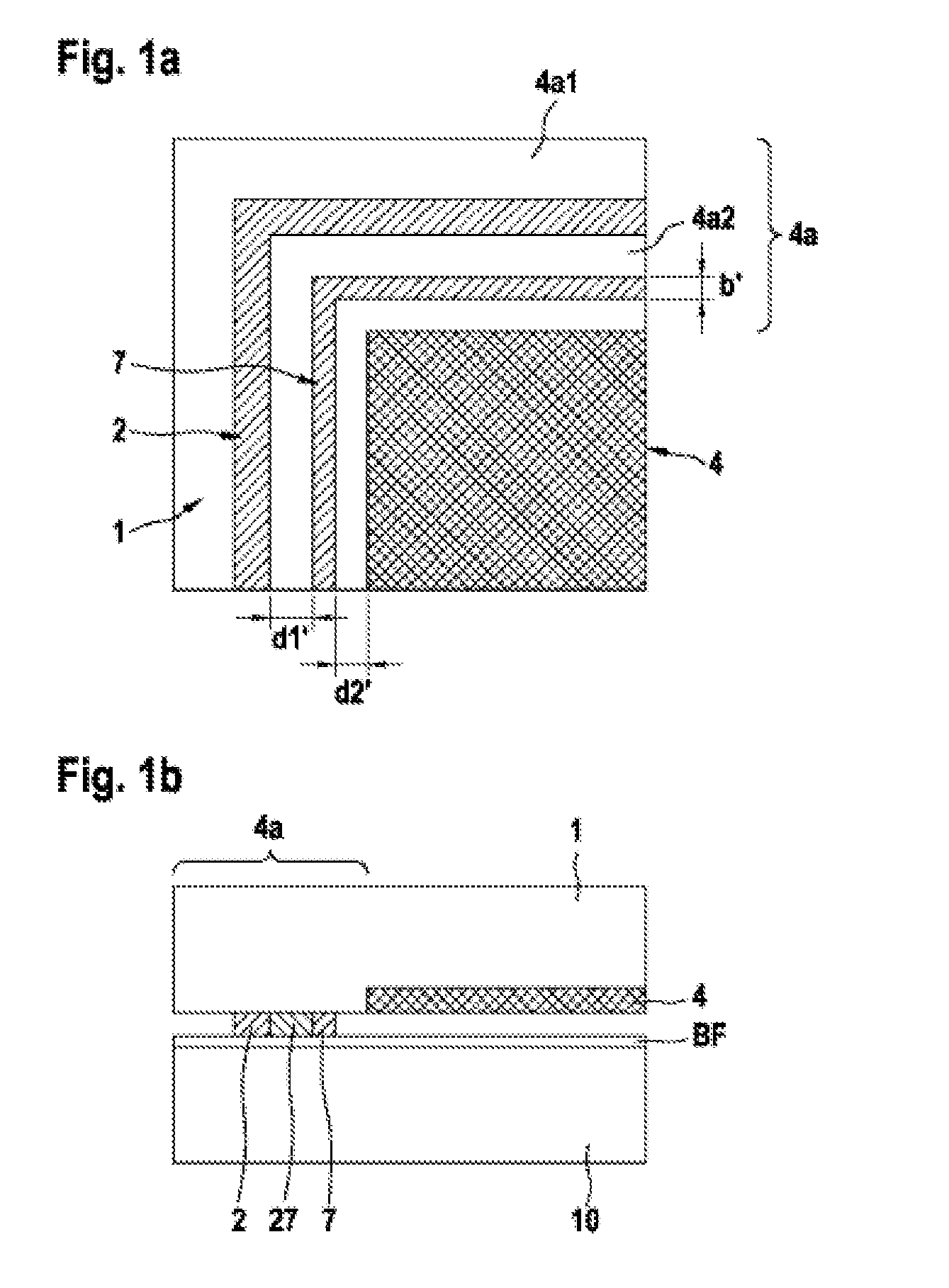Micromechanical Method and Corresponding Assembly for Bonding Semiconductor Substrates and Correspondingly Bonded Semiconductor Chip
a micromechanical and semiconductor chip technology, applied in semiconductor devices, semiconductor/solid-state device details, electrical apparatus, etc., can solve the problems of inconsiderable area requirement, liquid eutectic phase flowing into mems functional regions in an uncontrolled manner,
- Summary
- Abstract
- Description
- Claims
- Application Information
AI Technical Summary
Benefits of technology
Problems solved by technology
Method used
Image
Examples
first embodiment
[0024]FIG. 1a is a schematic partial plan view of a chip region of an assembly for bonding semiconductor substrates in accordance with the present invention.
[0025]The micromechanical sensor chip 1, which has an active functional region 4 and a passive edge region 4a. Provided in the edge region 4a is a bonding frame 2 with an applied eutectic bonding alloy, for example Al—Ge, which splits the edge region 4a into an inner region 4a2, which is surrounded by the bonding frame, and an outer region 4a1. A stop frame 7 is arranged in the inner region 4a2 between bonding frame 2 and functional region 4 of the sensor chip 1, said stop frame consisting of a non-eutectic alloy composed of Al and Ge, that is to say having either a higher Ge content or a higher Al content (up to the respective pure alloy component) than the corresponding eutectic alloy.
[0026]This additionally provided stop frame 7, upon contact with the flow movement (proceeding from the bonding frame 2) of the eutectic melt pr...
second embodiment
[0030]FIG. 2 is a schematic partial plan view of a chip region of an assembly for bonding semiconductor substrates in accordance with the present invention.
[0031]In the case of the second embodiment in accordance with FIG. 2, a double stop frame 7a, 7b with an interspace Z situated between the two stop frames 7a, 7b is provided. In the case of this second embodiment, in addition to altering the mixing ratio of the alloy out of the eutectic range, it is possible to utilize the capillary effect that forms between the two stop frames 7a, 7b, which are led in a parallel fashion, in the interspace Z. As a result of this capillary effect, relatively large amounts of a eutectic melt which occur locally can be rapidly distributed along the stop frames 7a, 7b by way of the interspace Z. This rapid distribution provides for the supply of a substantial amount of contact with the material of the stop frames, which accelerates the solidification, in order thus to be able to prevent even more eff...
third embodiment
[0033]FIG. 3 is a schematic partial plan view of a chip region of an assembly for bonding semiconductor substrates in accordance with the present invention.
[0034]In the case of the third embodiment in accordance with FIG. 3, a respective stop frame 7a′ and 7b′ composed of a non-eutectic alloy or one of the alloy components are provided both outside the bonding frame 2 and within the bonding frame 2.
[0035]Otherwise, the third embodiment corresponds to the first and second embodiments.
PUM
 Login to View More
Login to View More Abstract
Description
Claims
Application Information
 Login to View More
Login to View More - R&D
- Intellectual Property
- Life Sciences
- Materials
- Tech Scout
- Unparalleled Data Quality
- Higher Quality Content
- 60% Fewer Hallucinations
Browse by: Latest US Patents, China's latest patents, Technical Efficacy Thesaurus, Application Domain, Technology Topic, Popular Technical Reports.
© 2025 PatSnap. All rights reserved.Legal|Privacy policy|Modern Slavery Act Transparency Statement|Sitemap|About US| Contact US: help@patsnap.com



